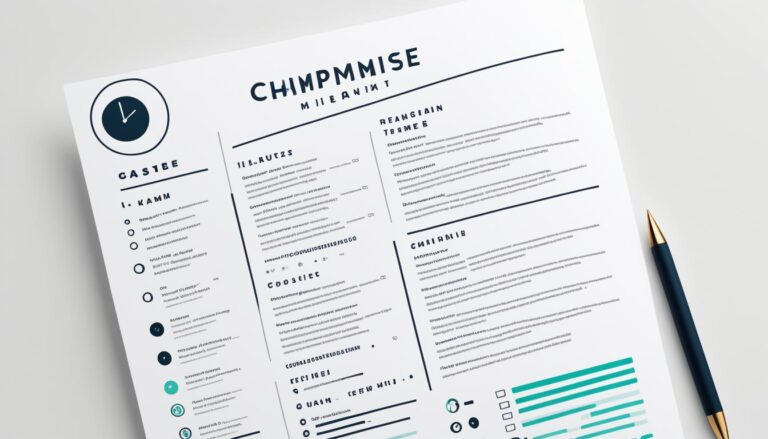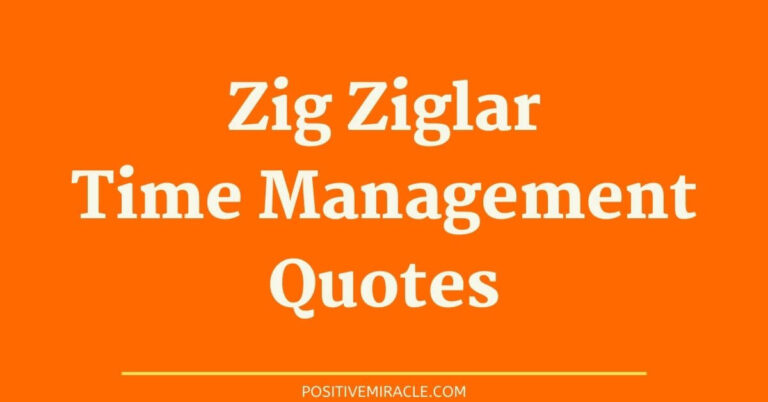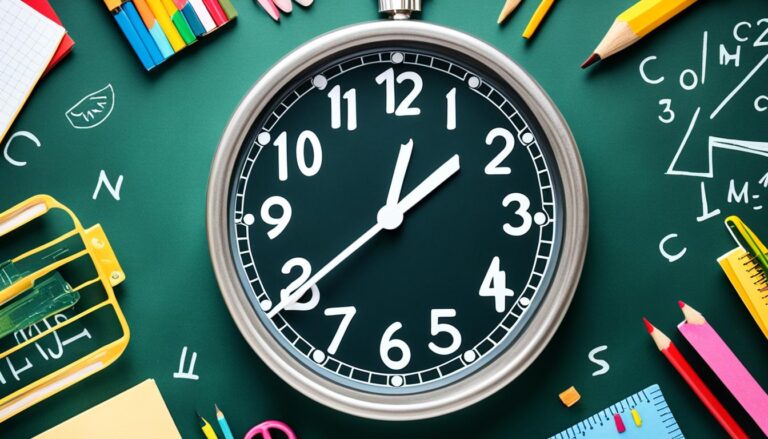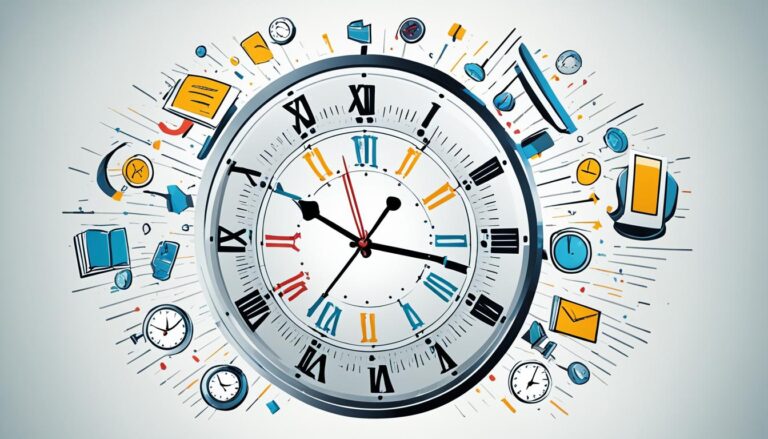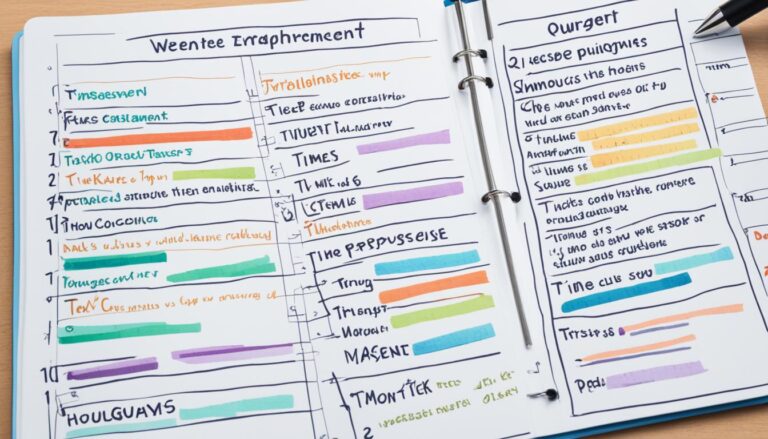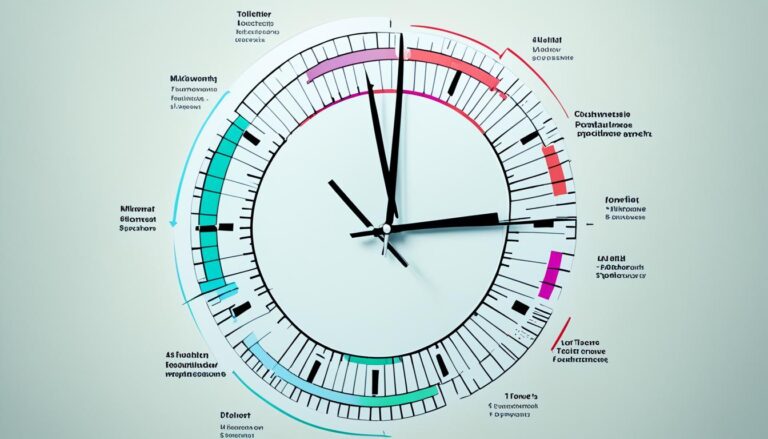Conquer Your Day: ADHD To-Do List Strategies
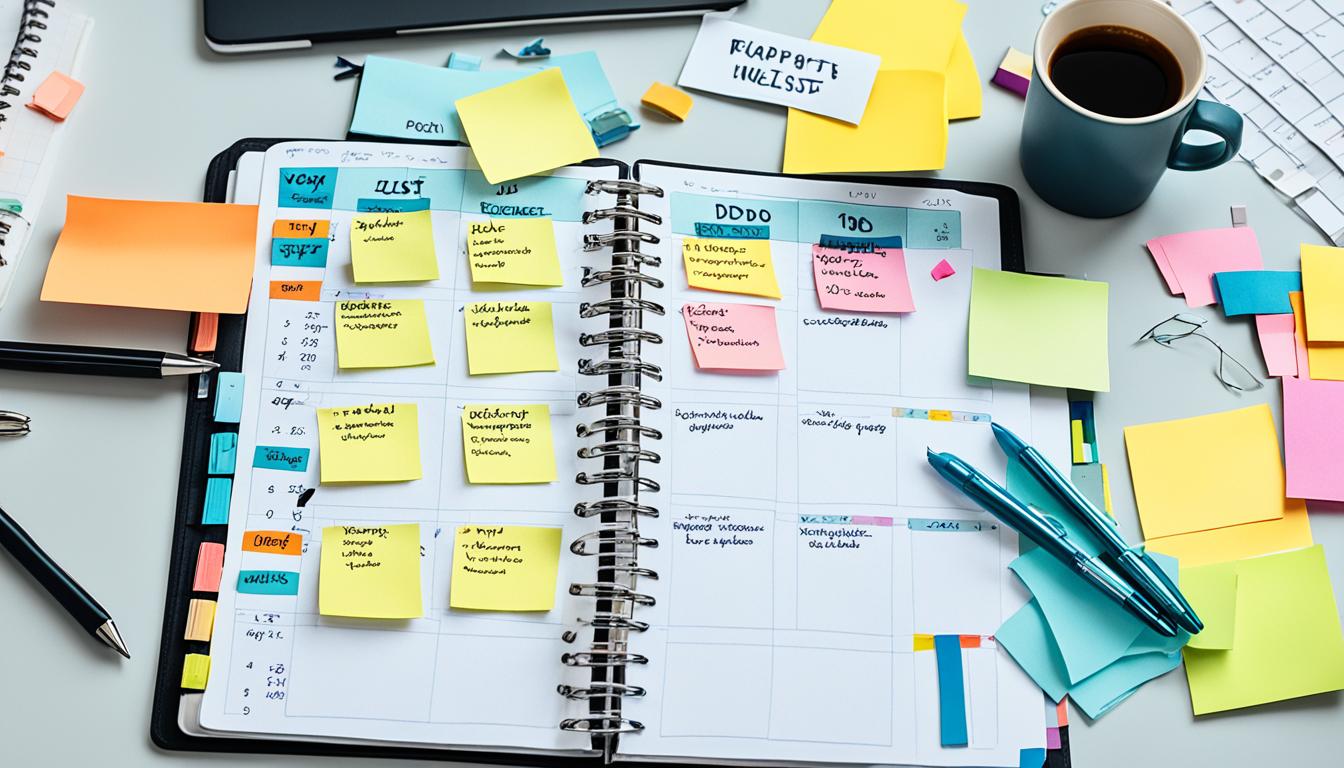
“The secret of getting ahead is getting started.” – Mark Twain
Organizing daily activities and schedules for adults with ADHD can be challenging. The ADHD brain is often clouded by hyperactive thoughts and impulsive behavior, making it difficult to fulfill responsibilities. To make daily life more systematic and organized, designing a personalized ADHD to-do list can help prioritize tasks and increase productivity. An ADHD to-do list is different from a regular list as it tends to be never-ending, and individuals with ADHD may struggle to trust simple lists. However, using a to-do list tailored to the unique needs of an ADHD brain can be highly effective in managing responsibilities and staying on track.
Key Takeaways:
- Creating an ADHD to-do list can help prioritize tasks and increase productivity.
- An ADHD to-do list is different from a regular list as it tends to be longer and more detailed.
- Limiting the list to 5-7 manageable tasks can prevent overwhelm.
- Breaking tasks into smaller, more manageable steps can reduce overwhelm and increase focus.
- Time blocking and visual reminders can enhance concentration and task completion.
What is an ADHD To-Do List?
Creating an effective ADHD to-do list is crucial for managing responsibilities and increasing productivity for individuals with ADHD. While a regular to-do list for neurotypical individuals is concise and manageable, an ADHD to-do list has some key differences to accommodate the unique challenges faced by those with ADHD.
Unlike a typical to-do list, an ADHD list tends to be longer and more detailed. This is because individuals with ADHD often struggle with overthinking and fear of feeling overwhelmed. By including more details and breaking down tasks into smaller steps, an ADHD to-do list can help alleviate these concerns and provide a clear roadmap for the day.
One of the core challenges for individuals with ADHD is maintaining focus and resisting distractions. It’s easy to get sidetracked by other tasks or thoughts, leading to a pile-up of unfinished responsibilities. An ADHD to-do list serves as a helpful reminder of what needs to be done and keeps individuals on track throughout the day.
To ensure the ADHD to-do list is effective, it’s essential to keep the list concise and realistic. Including an overwhelming number of tasks can lead to stress and decreased productivity. By limiting the list to a manageable number of tasks, individuals can focus on what truly needs to be accomplished and increase their chances of successfully completing them.
Incorporating effective ADHD productivity strategies, such as task planning methods and planner ideas, can further enhance the functionality of an ADHD to-do list. These strategies may include time blocking techniques, prioritization methods, and the use of visual aids.
Let’s take a look at a table that highlights some popular ADHD productivity strategies and task planning methods:
| ADHD Productivity Strategies | ADHD Task Planning Methods |
|---|---|
| Time blocking: Allocating specific time slots for different tasks | Breaking tasks into smaller steps |
| Prioritization: Identifying high-priority tasks and focusing on them first | Using a planner or digital calendar to organize tasks |
| Visual aids: Using color-coded markers or sticky notes to enhance organization | Setting reminders and utilizing alarms |
| Task bundling: Grouping related tasks together to increase efficiency | Utilizing technology such as task management apps |

By incorporating these strategies and customizing the ADHD to-do list to individual needs, individuals with ADHD can effectively manage their responsibilities and increase their productivity. Let’s dive deeper into actionable tips for creating an ADHD to-do list that works in the next section.
How to Create an ADHD To-Do List That Works
When it comes to managing your tasks and boosting productivity with ADHD, creating an effective to-do list is key. By customizing your list to suit your needs and incorporating specific strategies, you can stay organized and accomplish more each day. Here are some valuable tips to help you create an ADHD to-do list that works:
- Be Kind to Yourself: Remember that ADHD is a unique neurotype that comes with its own set of challenges. Avoid being too hard on yourself if you don’t accomplish everything at once. Set realistic expectations and prioritize self-compassion.
- Limit the Number of Tasks: To prevent feeling overwhelmed, it’s recommended to limit your list to 5-7 manageable tasks. By keeping it concise, you can focus on what’s most important and increase your chances of completing everything.
- Break Tasks Down: Big tasks can feel daunting, so break them down into smaller, more manageable steps. This approach reduces overwhelm and allows you to tackle each part one at a time, making progress towards your goals.
- Start with Easy Activities: Begin your day by accomplishing small, easy tasks. This builds momentum, boosts your confidence, and provides a sense of accomplishment right from the start. It can motivate you to tackle more challenging tasks later on.
- Prioritize and Schedule: Rank your tasks based on their importance and urgency. Make sure to schedule high-priority responsibilities at specific times. Time blocking, in particular, can be valuable for individuals with ADHD as it provides structure and helps combat difficulties with focus.
- Keep Your List Visible: Place your to-do list somewhere that you’ll see it regularly, such as your desk or phone’s home screen. This visual reminder serves as a constant prompt, helping you stay focused and on track throughout the day.
By implementing these strategies in your ADHD to-do list, you can enhance your productivity and effectively manage your tasks. Remember to stay flexible, adapt to changes, and celebrate your accomplishments along the way.
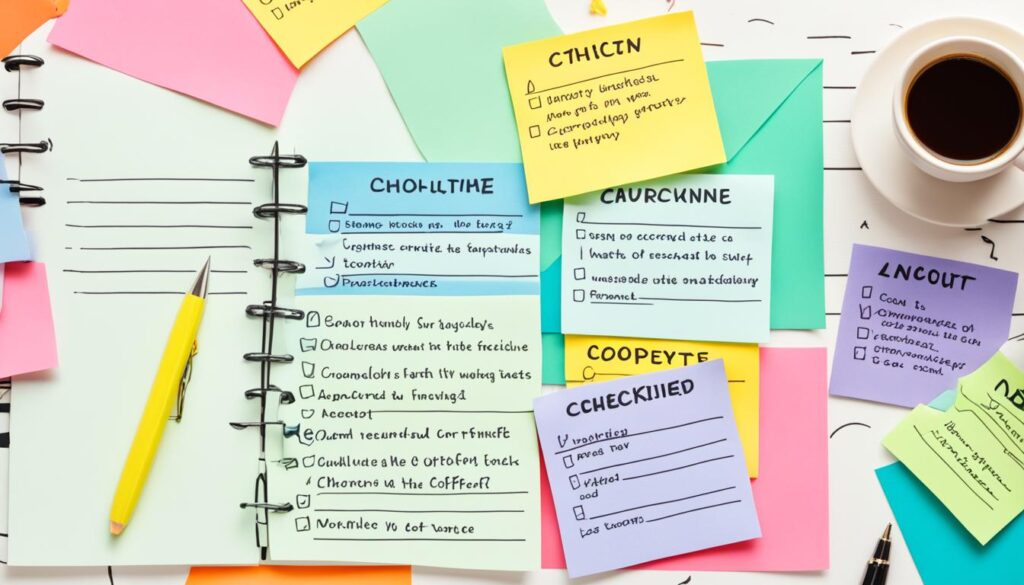
| Tip | Benefits |
|---|---|
| Be Kind to Yourself | Reduces self-criticism and fosters a positive mindset |
| Limit the Number of Tasks | Prevents overwhelm and improves focus on important tasks |
| Break Tasks Down | Makes tasks more manageable and reduces feelings of being overwhelmed |
| Start with Easy Activities | Builds momentum and boosts confidence |
| Prioritize and Schedule | Ensures critical tasks are completed on time and improves time management |
| Keep Your List Visible | Serves as a constant reminder and enhances concentration |
The Key to Getting Things Done: Work With Your Brain, Not Against It!
To improve productivity and effectively manage tasks with ADHD, it is important to work with your brain rather than against it. Overthinking and analysis paralysis can consume time and mental capacity, hindering productivity. Being mindful of these tendencies and focusing on listing essential and manageable objectives for the day can reduce overwhelm and increase the chances of successful task completion. Tailoring the to-do list to your unique ADHD needs, such as incorporating supports and rewards, can make tasks more interesting and bearable. Understanding and addressing sensory preferences can also contribute to staying on task and completing responsibilities.
ADHD individuals often struggle with time management, but by employing specific techniques, you can harness your strengths and overcome challenges. Here are some effective ADHD time management techniques:
- Prioritize: Determine your most important tasks and focus on accomplishing them first. This helps prevent overwhelm and ensures critical tasks are completed on time.
- Break tasks down: Large tasks can be daunting and overwhelming. Break them down into smaller, more manageable steps to make them more achievable.
- Time blocking: Allocate specific time blocks for different activities or tasks. This helps create structure and promotes focused work.
- Use reminders and alarms: Set reminders and alarms on your phone or calendar to keep track of important deadlines and appointments.
- Utilize visual cues: Visual aids, such as color-coded calendars or sticky notes, can help you stay organized and remember important tasks.
Remember, finding the right time management techniques may require some trial and error. Experiment with different strategies and adapt them to fit your unique needs and preferences.
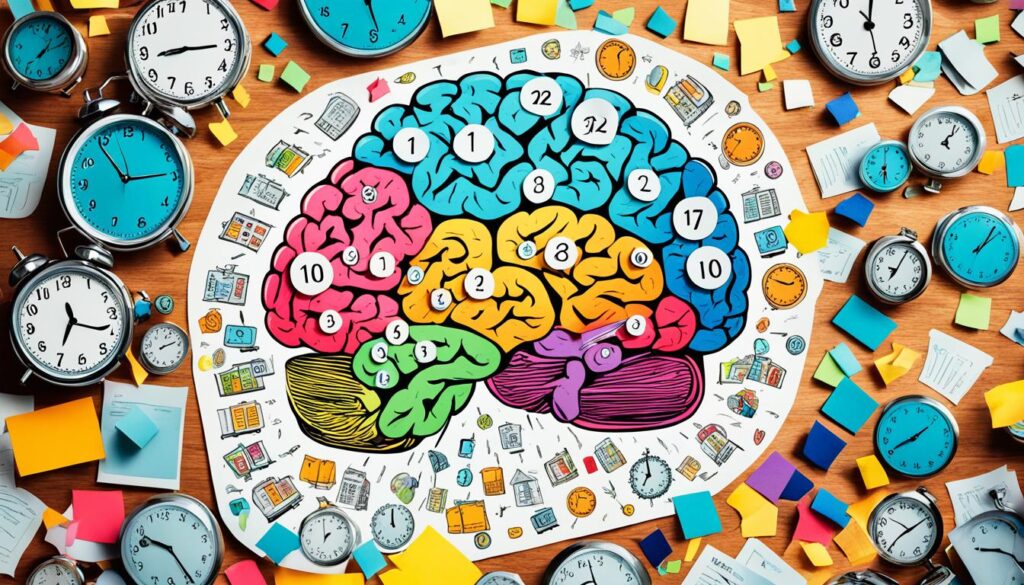
Comparative Analysis of ADHD Time Management Techniques
| Technique | Benefits | Challenges |
|---|---|---|
| Prioritize | Ensures critical tasks are completed on time | May neglect less urgent tasks |
| Break tasks down | Makes large tasks more manageable | May spend too much time breaking tasks down |
| Time blocking | Creates structure and promotes focused work | May struggle with following the allocated time blocks |
| Use reminders and alarms | Helps keep track of important deadlines and appointments | May become dependent on reminders and alarms |
| Utilize visual cues | Assists in staying organized and remembering tasks | May become overwhelmed with visual stimuli |
Tips for Overcoming Procrastination and Follow-Through
Procrastination can be a significant challenge for individuals with ADHD. However, by understanding the root causes of procrastination and implementing effective strategies, you can overcome this hurdle and improve your follow-through. Here are some helpful tips to get you started:
Identify the Reasons Behind Procrastination
One of the first steps in combating procrastination is understanding why it occurs. It could be due to sensory issues or feeling overwhelmed by the task at hand. By identifying these underlying factors, you can develop strategies to address them head-on.
Break Tasks Into Smaller Steps
Large, intimidating tasks can trigger procrastination. Break them down into smaller, more manageable steps. This allows you to build momentum and makes the task feel less overwhelming. By tackling one step at a time, you’ll find it easier to stay on track and complete the overall task.
Start with Less Challenging Activities
Often, starting a task is the most challenging part. To combat this, begin your day with smaller, easier activities. This helps ease you into a productive mindset and builds confidence. As you complete these tasks, you’ll feel motivated to tackle more challenging ones.
Utilize Effective Strategies
There are several strategies that can help improve follow-through and reduce procrastination. Here are a few techniques to consider:
- Set timers: Use timers to create dedicated blocks of time for focused work. Knowing that there is a set time for each task can increase motivation and prevent distractions.
- Find a “body double”: Working alongside someone else can provide a sense of accountability and reduce distractions. This individual doesn’t necessarily need to be working on the same task as you, but their presence can help you stay focused.
- Incorporate enjoyable activities or rewards: Break up your tasks by incorporating activities or rewards that you enjoy. This can help you stay motivated and engaged while completing your responsibilities.
By implementing these strategies, you can overcome procrastination and improve your ability to follow through on tasks.
Remember, awareness of your tendency to procrastinate is key. By addressing the underlying factors and implementing effective strategies, you can increase your productivity and achieve greater task completion.

Strategies for Overcoming Procrastination and improving follow-through
| Strategy | Description |
|---|---|
| Identify the Reasons Behind Procrastination | Understand why you tend to procrastinate. Is it due to sensory issues or feeling overwhelmed? By identifying the root cause, you can develop targeted strategies to address it. |
| Break Tasks Into Smaller Steps | Large tasks can be daunting and lead to procrastination. Break them down into smaller, more manageable steps to make them feel less overwhelming and easier to tackle. |
| Start with Less Challenging Activities | Begin your day with smaller, easier tasks. This helps build momentum and confidence, making it easier to transition to more challenging responsibilities. |
| Set Timers | Use timers to create dedicated blocks of focused work. Knowing you have a set time for each task can increase motivation and reduce distractions. |
| Find a “Body Double” | Work alongside someone else, even if they are not working on the same task. Their presence can provide accountability and help you stay focused. |
| Incorporate Enjoyable Activities or Rewards | Break up tasks by including enjoyable activities or rewards. This keeps you motivated and engaged as you work towards completing your responsibilities. |
Conclusion
Creating and utilizing an ADHD to-do list can be a game-changer when it comes to managing responsibilities and increasing productivity. By tailoring the list to your individual needs, setting achievable goals, and implementing effective strategies such as breaking tasks down and prioritizing, you can conquer your day and improve overall organization.
Remember to be kind to yourself throughout this journey. ADHD brings its own set of challenges, and it’s essential to adapt and embrace them. Work with your brain, not against it. Discover the strategies that work best for you and incorporate them into your daily routine.
With the right approach and techniques in place, you can unlock your full potential and accomplish your goals. So, start creating your personalized ADHD to-do list today, and watch as your productivity soars, your tasks get done, and you regain control over your time and life.

